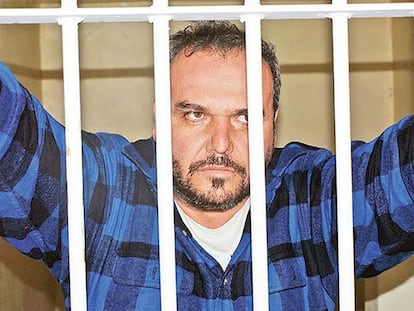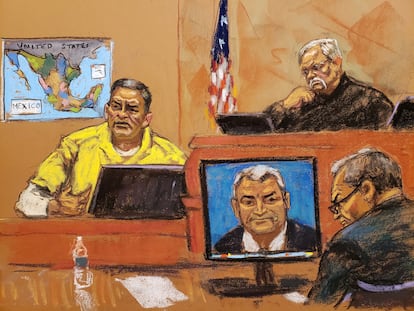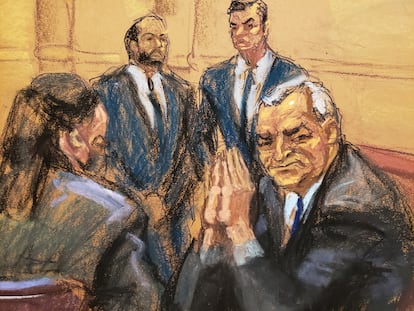Sinaloa Cartel capo says he personally delivered bribe money to Genaro García Luna
Jesús ‘Rey’ Zambada testified to handing over millions of dollars to the former Mexico security chief, who has elected not take the stand during his New York trial

Jesús “Rey” Zambada, the younger brother of Ismael “El Mayo” Zambada, one of the founders of the Sinaloa Cartel along with Joaquín “El Chapo” Guzmán is the last convicted drug lord who will testify for the prosecution in the New York trial of Genaro García Luna, Mexico’s former chief of public security during the Felipe Calderón administration (2006-2012). Mexico’s former drug czar informed Judge Brian Cogan on February 13 that he would not testify in his own defense. “Yes, sir. That’s my decision,” the defendant replied when asked by the judge if he intended to take the stand. Moments later, Zambada began his testimony. “I met him in person once,” he said, “when I delivered some money to him.”
Zambada said the Sinaloa Cartel paid millions in bribes to García Luna in late 2006. He said that the criminal organization gave him at least $5 million as payment for two in-person meetings shortly before the end of the Vicente Fox administration (2000-2006). “I have an opportunity to meet with Genaro García Luna. Reliable sources tell me he is going to be the new secretary of Public Security,” Oscar Paredes told Zambada. Paredes was a cartel lawyer who managed relationships with government officials. “We had to give him $3 million just to meet with him,” Zambada testified.
Zambada had only one condition – the meeting had to take place in an open area so he could watch from a distance. “We put some money in a big briefcase, like the ones lawyers use,” he said. “The rest we put in one of those large duffel bags used by athletes.” El Rey was in charge of collecting all the cash, and Paredes later delivered it to García Luna’s people.
Zambada arrived early at a restaurant named Champs Elysées, which is very close to the US Embassy on one of Mexico City’s main boulevards. He got into position to watch the meeting between the cartel lawyer and García Luna, the director of the Federal Ministerial Police (AFI) at the time. The two men met in a private room on the restaurant’s second floor. “I saw Genaro García Luna and two men emerge after 15 minutes,” said Zambada. One of the men was carrying the briefcase, and the other, the duffel bag.
Afterward, Zambada asked Paredes how the meeting went. “He told me that my brother [Mayo Zambada] wasn’t going to have any problems, that they would leave him alone… [García Luna] already had an arrangement with the Beltrán Leyva brothers and was going to do the same for us.” Paredes and García Luna agreed to meet again three weeks later. “He told me we needed $2 million for the second meeting,” said Zambada. The second meeting also took place in Champs Elysées, a site previously identified by a US Drug Enforcement Administration (DEA) agent during the trial as a frequent meeting place for narcos and Mexican officials.
Paredes asked Zambada to go up to the restaurant’s second floor for the next meeting to wait for García Luna. “That’s where we were when there was a knock on the door,” said El Rey with a dramatic pause. “He came in and said: ‘Very pleased to meet you,’ and held out his hand. I was astonished,” Zambada, who liked to keep a low profile, told the court. Since he didn’t want to get involved in the negotiations, he left the room. “I wasn’t interested in him knowing me or who I was,” he explained. “I stayed out of trouble before I was arrested.”
Jesús Zambada was the head of the Sinaloa Cartel in Mexico City from 2000 until his arrest in October 2008. Four years later, he was extradited to the United States. “Support from [Mexican] government officials is needed [in the drug business],” said the witness, who has collaborated with US authorities for more than 10 years. Zambada also testified against El Chapo Guzmán. “The leaders always try to maintain relationships at the highest levels,” he said.
Sinaloa kingpin reveals scale of police cooperation
Zambada’s testimony is consistent with other witnesses like Sergio “El Grande” Villarreal Barragán and Oscar “Lobo” Nava Valencia. Both testified earlier in the trial that the cartel benefited from widespread government support and that the García Luna connection dated back to his tenure at the AFI. “We managed the government relationships through the attorney, Paredes,” said Zambada. He also described the cartel’s control of the Mexico City airport, which aligns with the earlier testimony of Israel Avila (a mid-level Sinaloa Cartel operative) and Raúl Arellano (a former federal police officer). He also digressed briefly to talk about El Chapo’s first escape in 2001 and how he picked him up in a helicopter without interference from the authorities.
High-ranking Federal Police officers were also on the cartel payroll. People like Édgar Bayardo and Guillermo Báez Figueroa (Mayo Zambada’s nephew) “worked for me,” said Zambada. Some AFI agents under García Luna even invested in cocaine purchases from Colombia. The witness said that Ramón Pequeño, a co-defendant in the trial, also took money from the Sinaloa Cartel, as did Federal Police Commissioner Facundo Rosas. Báez Figueroa was arrested in 2008 amid controversy over his relationship with the Zambada family.
Although not much was made of it during the trial, Zambada said he had his own AFI identification card. He described paying hundreds of thousands of dollars for Bayardo to be promoted up the ranks of the Deputy Attorney General’s Office for Organized Crime and that the money was channeled through Victor Hugo García, Genaro García Luna’s nephew. Bayardo, a source of sensitive information for the Sinaloa Cartel, was gunned down in 2009.
Jesús Zambada was extradited from Mexico in 2012 and signed a collaboration agreement with US authorities a year later. In March 2020, after pleading guilty and helping to bring down El Chapo, Zambada was sentenced to 12 years for organized crime and drug trafficking. But he was released a few days later after being credited with time served in Mexico and the US.
Federal prosecutors surprised everyone by announcing that Jesús Zambada would be the final cooperating witness to testify against García Luna. This unexpected move cuts the timetable for the trial, reshapes the political debate and forces all parties to make crucial decisions quickly. Both sides are scheduled to present closing arguments in the coming days, followed by jury deliberation.
Sign up for our weekly newsletter to get more English-language news coverage from EL PAÍS USA Edition
Tu suscripción se está usando en otro dispositivo
¿Quieres añadir otro usuario a tu suscripción?
Si continúas leyendo en este dispositivo, no se podrá leer en el otro.
FlechaTu suscripción se está usando en otro dispositivo y solo puedes acceder a EL PAÍS desde un dispositivo a la vez.
Si quieres compartir tu cuenta, cambia tu suscripción a la modalidad Premium, así podrás añadir otro usuario. Cada uno accederá con su propia cuenta de email, lo que os permitirá personalizar vuestra experiencia en EL PAÍS.
¿Tienes una suscripción de empresa? Accede aquí para contratar más cuentas.
En el caso de no saber quién está usando tu cuenta, te recomendamos cambiar tu contraseña aquí.
Si decides continuar compartiendo tu cuenta, este mensaje se mostrará en tu dispositivo y en el de la otra persona que está usando tu cuenta de forma indefinida, afectando a tu experiencia de lectura. Puedes consultar aquí los términos y condiciones de la suscripción digital.
More information
Archived In
Últimas noticias
Maduro counterattacks Trump with rhetoric and announces downing of nine drug trafficking aircraft
‘Ecce Homo’: The miraculous disaster that made a small Spanish town famous
Return to sex testing at the Olympics: IOC edges closer to banning transgender women
Trump escalates conflict with Venezuela with the start of covert operations
Most viewed
- Sinaloa Cartel war is taking its toll on Los Chapitos
- Oona Chaplin: ‘I told James Cameron that I was living in a treehouse and starting a permaculture project with a friend’
- Reinhard Genzel, Nobel laureate in physics: ‘One-minute videos will never give you the truth’
- Why the price of coffee has skyrocketed: from Brazilian plantations to specialty coffee houses
- Silver prices are going crazy: This is what’s fueling the rally











































